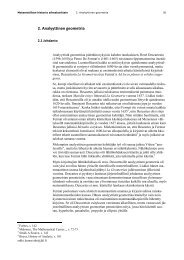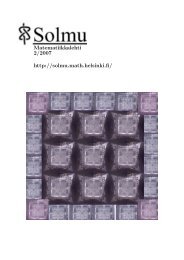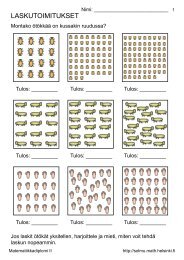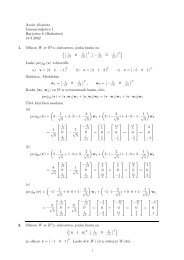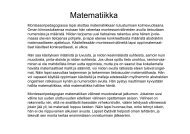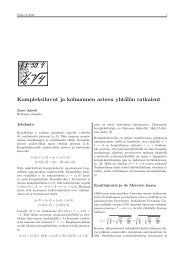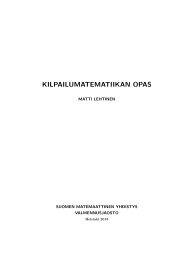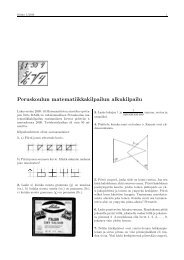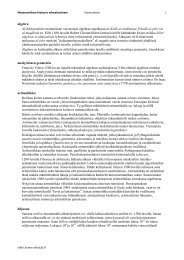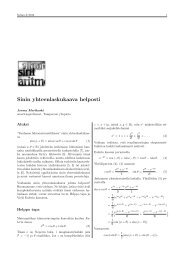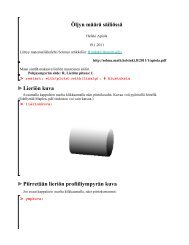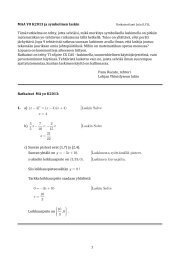Speech to Song Illusion: Evidence from Mandarin Chinese
Speech to Song Illusion: Evidence from Mandarin Chinese
Speech to Song Illusion: Evidence from Mandarin Chinese
Create successful ePaper yourself
Turn your PDF publications into a flip-book with our unique Google optimized e-Paper software.
SPEECH TO SONG ILLUSION: EVIDENCE FROM MC 5rates, fast, mid, and slow, with a broad focus.The pitch intervals of the <strong>to</strong>nes are either 5 st or7 st (perfect fourth or perfect fifth), thusfacilitating the generation of the effect:Table 3Preliminary results of perceptual trialexperiments showed that this cu<strong>to</strong>ff value isindeed responsible for the generation of theeffect. Only the slow speech rate generated theperceptual shift <strong>from</strong> speech-like signal <strong>to</strong> thesong-like signal, while the other two do notexhibit this effect no matter how many times therecording is repeated. Moreover, the illusionseems <strong>to</strong> disappear when synthesizedacceleration is applied on the slow rate sentence.In sum, when the cu<strong>to</strong>ff value of Xu’sTarget Approximation model is applied, thetarget stability is demonstrated <strong>to</strong> be crucial forthe generation of speech <strong>to</strong> song illusion. This isin agreement with Falk and Rathecke’s work onGerman. Future perceptual experiments areneeded <strong>to</strong> decide the details of the illusion inMC.IV Interval StructureThe question of interval structure in thespeech <strong>to</strong> song illusion is proved <strong>to</strong> becomplicated in MC, considering the flexibility of<strong>to</strong>ne production and perception in MC, as well asthe interaction between lexical <strong>to</strong>ne andin<strong>to</strong>nation (Shen 1990; Xu 1994). Whenrealizing transitions <strong>from</strong> one <strong>to</strong>ne <strong>to</strong> another inreal-time speech in MC, for instance, <strong>from</strong> thethird <strong>to</strong>ne <strong>to</strong> the first <strong>to</strong>ne, because the <strong>to</strong>nes aredefined relatively, there is a range of acceptedintervals (i.e. all the different intervals that mightbe interpreted as accepted third <strong>to</strong>ne <strong>to</strong> first <strong>to</strong>netransition in real speech). The robustness of thisinterval is true especially when we consider thatMC preserves an over 90% of intelligibilityspoken in mono<strong>to</strong>ne in a non-noisy background(Xu&Patel&Wang 2010). The change in broadand narrow focus semantically also is reflected inprosody, thus in <strong>to</strong>ne intervals.For the current study I use the same samplesentence <strong>from</strong> above. First I ask a question: Howis <strong>to</strong>ne interval mapped on<strong>to</strong> the specific <strong>to</strong>nerelations, such as a transition <strong>from</strong> <strong>to</strong>ne 3 <strong>to</strong> <strong>to</strong>ne1? In a series of trial experiments, the samplesentence (with third <strong>to</strong>ne vs. first <strong>to</strong>ne contrast)was read by male native MC speaker using awide range of intervals <strong>from</strong> smaller than 1 st <strong>to</strong>12 st. Results indicate that all intervals producedare accepted as normal speech (presumablyheard in different context). One explanation forthis is that when third <strong>to</strong>ne is contrasted with thefirst <strong>to</strong>ne in MC, there is no possible confusionas the other two <strong>to</strong>nes in the inven<strong>to</strong>ry are risingand falling <strong>to</strong>nes with large intervals and greaterspeed of pitch change, with no other level <strong>to</strong>nes<strong>to</strong> confuse with. Thus, as long as the third <strong>to</strong>netransits in<strong>to</strong> a first <strong>to</strong>ne in an ascending interval,presumably it can be accepted as intelligible and<strong>to</strong>lerable in normal speech. (While on the otherhand, if a descending interval is heard in thiscase it inflects a <strong>to</strong>ne accent <strong>from</strong> a differentdialect of MC, while still being intelligible inthis case). To confirm this empirically, I intend<strong>to</strong> build a corpus collecting material in realspeech and study the interval range of the level<strong>to</strong>ne contrasts.More strikingly, in one trial of the abovementionedreading where the speaker intends <strong>to</strong>speak in a small interval (such as 1 st), we foundthat in a <strong>to</strong>ne pattern of (3-1-1-1-1-1), the firstfour words are actually assigned the about samepitch height, while the last two <strong>to</strong>nes are about 1-2 st higher (Table 4). In a similar trial, anascending pattern is found within the realizationof the five first <strong>to</strong>ne words, thus assigning thefive first <strong>to</strong>ne words different pitch heights in anascending fashion.5



